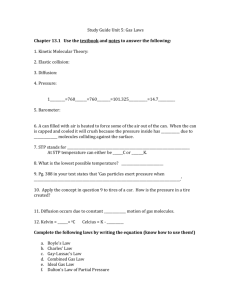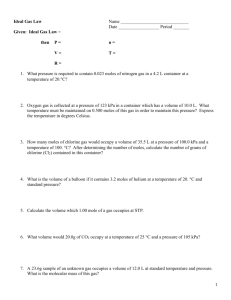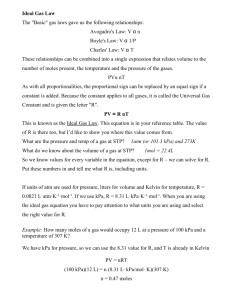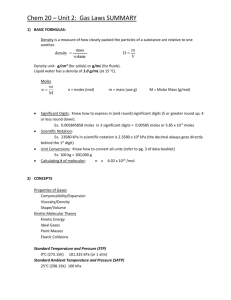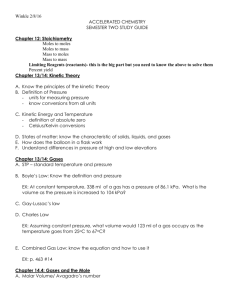Unit 5: ideal Gases
advertisement
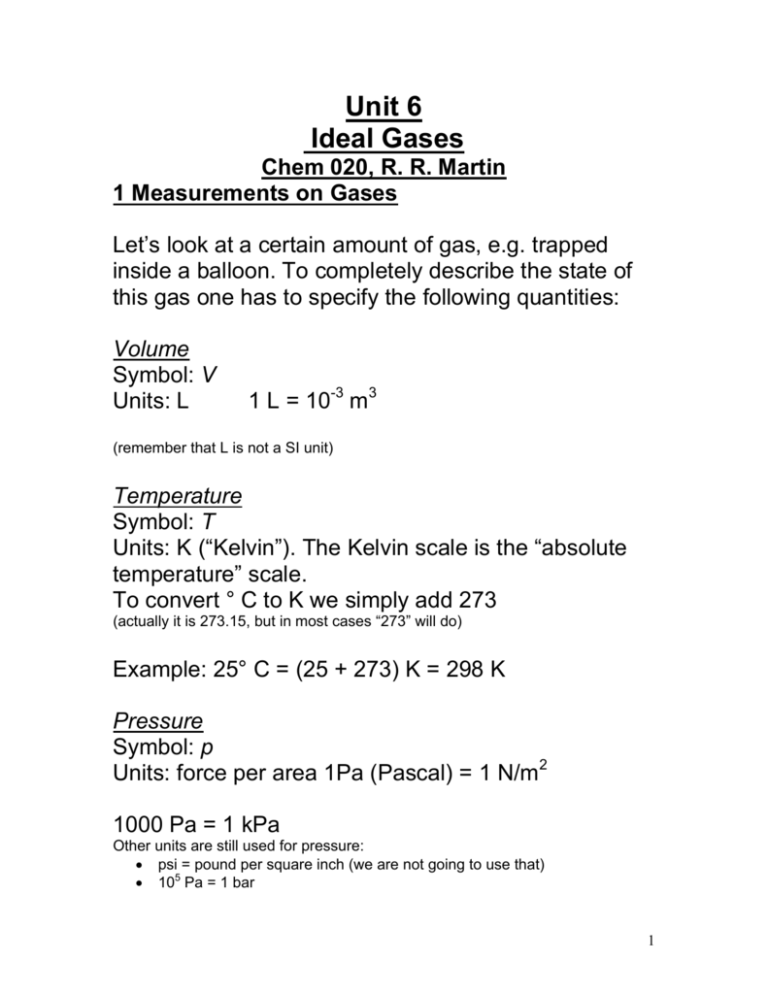
Unit 6 Ideal Gases Chem 020, R. R. Martin 1 Measurements on Gases Let’s look at a certain amount of gas, e.g. trapped inside a balloon. To completely describe the state of this gas one has to specify the following quantities: Volume Symbol: V Units: L 1 L = 10-3 m3 (remember that L is not a SI unit) Temperature Symbol: T Units: K (“Kelvin”). The Kelvin scale is the “absolute temperature” scale. To convert ° C to K we simply add 273 (actually it is 273.15, but in most cases “273” will do) Example: 25° C = (25 + 273) K = 298 K Pressure Symbol: p Units: force per area 1Pa (Pascal) = 1 N/m2 1000 Pa = 1 kPa Other units are still used for pressure: • psi = pound per square inch (we are not going to use that) • 105 Pa = 1 bar 1 • 101300 Pa = 101.3 kPa = 1.013 bar = 1 atm = 760 mm Hg (= 760 Torr) A mercury barometer can be used for measuring gas pressure “Normal pressure” corresponds to 101.3 kPa = 760 mm Hg ( =1 atm). The Hg level will be lower when you move this device from the basement to the third floor, or when a rainstorm is moving in (why?) 2 2. Number of Moles With gases, as with any other substances we can use the relationship m = MM × n to convert mass (m) to number of moles (n), if we know the molar mass (MM). Example: How many moles of N2 molecules are there in 2.50 g? m = 2.50g MM = 28 g/mol or 2.50g = 28 g/mol x n n= (2.50g)/(28g/mol) = .089 mol 3 Calculations involving gases can be confusing because of the different units that are sometimes used for the same quantity. That means: before you do any calculations • • • • Convert the volume to L Convert the pressure to kPa Convert the temperature to K Convert the “amount” of material to moles … and you’ll be OK ☺ 4 3 The Ideal Gas Law Pressure, temperature, volume, and number of moles are related by the ideal gas law: P×V=n×R×T where R = 8.31 L kPa mol-1 K-1 is a constant If you use this value of R in calculations, V has to be in L, p has to be in kPa !!!! (In SI units: R = 8.31 J mol-1 K-1) Although this law only applies to “ideal” gases (meaning that the molecules do not interact with each other, individual gas molecules have zero volume) it describes the behavior of real gases (He, O2, N2, … remarkably well). Remember: n is the number of gas molecules (not gas atoms !!!!), i.e. for 1 mol He n = 1 for 1 mol N2 n = 1 5 What does the ideal gas law tell us? Let’s try this for V • The volume is proportional to the number of moles (for fixed T, fixed p): V = (nRT)/P • The volume is proportional to the temperature (for fixed n, fixed p): V = (nRT)/P • The volume is inversely proportional to the pressure (for fixed n, fixed T) V = (nRT)/P 6 Example: How much volume is occupied by one mole of gas at standard temperature and pressure (“STP”), i.e. 0° C and 101.3 kPa (1 atm)? V = (nRT)/P = (1.0 x 8.31 L kPa mol-1 K-1 x 273 K)/(101.3 kPa) = 22.4 L This result does not depend on the nature of the gas! 1 mol He occupies the same volume as 1 mol Cl2 … 7 Postulates of the Ideal Gas Law: 1. Gases are composed of molecules in rapid random motion. The kinetic energy of the gas molecules depends on the temperature, pressure results from collision of the gas molecules with the container walls. 2. The gas molecules do not exert any forces on each other. 3. The volume of the gas molecules themselves are negligible compared to the volume of the container. These postulates work surprisingly well. Molecules do exert attractive forces on each other but the attraction may be ignored when the molecules are far apart (low pressure, or high temperature); in addition, the molecules do have a volume of their own but this volume may also be neglected at low pressure. Under non-ideal conditions (high pressure and/or low temperature) a refinement of the ideal gas law is used, usually the Van Der Waals equation. 8 Dec. 2004 exam question: Find # moles of gas originally present: n = (PV)/RT = (5000 x 25)/(8.31x 293) = 51.3 # of moles after release: n = (2000 x 25)/(8.31 x 293) = 20.5 Moles released = 51.3 – 20.5 = 30. 9 4. More Gas Law Calculations Final and Initial State Problems A gas often undergoes a change from an initial to a final state. Example: Consider a sample of gas at 25° C and 101.3 kPa (1.000 atm) [initial state, state1]. What is the pressure if the gas is heated to 100° C at constant volume [final state, state2]? Using the ideal gas law, and remembering that n = const, V = const (and, of course R = const), we find that Initial state: P1V = nRT1 Final state: P2V = nRT2 If n = const, but p, V, T change you have P1V1 = nRT1 P2V2 = nRT2 such that P1V1 / T1 = (remember this for the gases prelab) P2V2 / T2 Here: P1 = 101.3 kPa, P2 = x, T1= 298 K, T2= 373 K, V1 = V2 So that: (101.2 V1)/298 =(x V1)/373 (373/298) = 126.7 kPa x= P2 = 101.2 x 10 Molar Mass and Density The ideal gas law offers a simple approach to the experimental determination of the molar mass of a gas. This method can also be applied to volatile liquids (i.e. liquids that evaporate easily, e.g. “nail polish remover” [= acetone]). A simple derivation shows how this might be done: PV = nRT N = mass/MM or PV = (mass/MM)RT or: P x MM = (mass/V) x RT but: mass/V = density (d) so that: MM = (dRT)/P 11 Example: A sample of liquid acetone is placed in a 3.00 L flask and vaporized by heating to 95° C at 103.3 kPa (1.02 atm). The vapor filling the flask at this temperature and pressure weighs 5.87 g (you can assume that there is no air left in the flask, i.e. it contains only acetone vapor). a) What is the density of acetone vapor under these conditions? b) Calculate the molar mass of acetone. a) d = mass/vol = 5.87g/3.00L = 1.96 g/L b) MM = dRT/P = (1.96 g/L x 8.31 L kPa mol-1 K-1 x 368 K)/ (103.3 kPa) MM = 58 g/mol How does this compare to the expected molar mass of acetone [molecular formula CH3-CO-CH3 ] ? Same 12 Dec 2004 exam question: MM = (dRT)/P = 131.3g/mol = (d x 8.31 L kPa mol-1 K-1 x 298 K)/1.01 kPa d = 5.4 x 10-2g/L 13 … and another one We want We can start with any arbitrary mass of Br2(l) , 3.12 g looks like a good choice because we know the volume of this mass = 1 mL = 0.001 L Now all we need to know is what volume this much bromine as a gas would occupy under the conditions given. Since it is a gas; PV = nRT P = 1 atm = 101.3 kPa (normal boiling point) V = Volume Br2(g) n = mass/MM = 3.12g/159.8 g/mol recall MM for Br2 = 159.8g = .0195 mol R = 8.31 L kPa mol-1 K-1 T = 58.7 + 273 = 331.7 K Volume Br2(g) = (0.0195 mol x 8.31 L kPa mol-1 K-1 x 331.7 K)/ 101.3 kPa = 0.530 L Expansion factor = (Volume Br2(g))/ (Volume Br2(l)) = 0.530 L/0.001 L = 530 14 5. Stoichiometry of Gaseous Reactions We already know how to relate moles of substance to grams of substance (using m = MM × n). For gas reactions we can now also include volume and pressure. The following Dec 2004 exam question . The balanced equation is: C5H12 + 8O2 → 5CO2 + 6 H2O We need 8 moles O2 for each mole C5H12 We have 5/72 = 0.0694 moles C5H12 Need 8 x 0.0694 = 0.556 moles O2 Volume O2 required = nRT/P = (0.556 x 8.31 L kPa mol-1 K-1 x 293 K)/100 kPa = 13.5 L 15 Gay-Lussac discovered the law of combining volumes: The volume ratio of any two gases in a reaction at constant temperature and pressure is the same as the reacting mole ratio. Example: Synthesis of ammonia N2 (g) + 3 H2 (g) 2 NH3 (g) 1 molecule of N2 and 3 molecules of H2 will produce 2 molecules of NH3 1 mole of N2 and 3 moles of H2 will produce 2 moles of NH3 1 L of N2 and 3 L of H2 will produce 2 L of NH3 10 m3 of N2 and 30 m3 of H2 will produce 20 m3 of NH3 and … This works, because V =(RT/p ) × n The volume is proportional to the number of moles! Analogously, this works with partial pressures 16 Feb 2005 exam question: Since volumes are interchangeable with moles the equation is: 2 CxHyOz + 5O2 → 4CO2 + 4H2O Now moles C in 2 CxHyOz = moles C in 4 CO2 So 2x = 4 x= 2 Formula so far = C2HyOz And; Moles H in 2 C2HyOz = moles H in 4H2O So: 2 y = 4 x2 y= 4 Formula so far = C2H4Oz Now moles O on reactant side = moles O on product side: 2z + 10 = 12 z = 1 Formula is: C2H4O 17 6. Gas Mixtures: Partial Pressures and Mole Fractions The ideal gas law applies to all gases, therefore it should also apply to gas mixtures (e.g. air). Consider a mixture of two gases at constant volume and temperature (moles gas A = nA, moles gas B = nB), the total pressure is given by B ptot = ntot × RT/V = (nA + nB) × RT/V = nA × RT/V + nB × RT/V = pA + pB B B B pA and pB are the same pressures that gas A and gas B would exert if they were alone. They are referred to as partial pressures. B The total pressure is the sum of the partial pressures of all gases In this case: ptot = pA + pB B The partial pressures are simply calculated from the ideal gas law: pA = nART/V pB = nBRT/V B B 18 If there are more than two gases: ptot = pA + pB + pC + … B This is known as Daltons Law of Partial Pressures: “The total pressure of a gas mixture is the sum of the partial pressures of the components of the mixture.” And in a gas mixture: PA = XAPT XA = mole fraction of gas A = moles a/ total moles gas in mixture 19 Dec 2004 exam question: PT = PHe + PH2 = 100.0 kPa PH2 = X H2PT PHe = XHePT The total # of moles of gas in the system may be found using PV = nRT n = RT/PV = 8.31 x 302/ 100 x 23 = 1.09 moles H2 = mass/molar mass = 0.475/2 = 0.2875 moles He = moles total – moles H2 = 1.09 – 0.2875 = 0.8 PHe= XHePT = ((moles He)/(moles He + moles H2)) x PT =(( 0.8)/(0.8 + .2875)) x 100 = 73.4 20 Dec 2004 exam question: Before reaction: PT(initial) = PC2H2(initial) + PH2(initial) = 52.0 kPa After reaction: PT(final) = PC2H6(final) + PH2(final) = 34.0 kPa Now since 1 mole C2H2 yields 1 mole C2H6 and H2 is in excess, after reaction PC2H2(initial) = PC2H6(final), so that: PT(initial) - PT(final) = PH2(initial) - PH2(final) = 52 – 34 = 18 kPa = ∆ PH2 Now: 2 moles H2 react with 1 mol C2H2 or (∆ PH2)/2 = PC2H2(initial) . PC2H2(initial) = 18/2 = 9 kPa 21 7. Wet Gases, Partial Pressure of Water Consider the following arrangement: A closed container contains some liquid water and a gas (say N2). Mixture of N2 and water vapor Liquid water Q. What is the total pressure of the gas? A. It is the partial pressure of the N2, plus that of the water vapor. ptot = pN2 + pH2O The partial pressure of the water vapor is equal to the so-called vapor pressure of liquid water. It has a fixed value at a given temperature. 22 The vapor pressure of water is independent of the amount of liquid water (… as long as there is any liquid water)! Vapor pressure of water as a function of temperature. (taken from lab manual) An example of an experiment where this is important is the following: Zn + 2H+ Zn2+ + H2. The H2 gas is collected by displacing water … The total pressure of the collected gas is pH2 + pH2O. Example: Electrolysis of water Hydrogen gas is prepared by electrolyzing water at 25° C. 152 mL of hydrogen are collected at a total pressure of 101 kPa. What is the partial pressure of hydrogen under these conditions? 23 ptot = pN2 + pH2O = 101 kPa = pN2 +3.17 kPa (from table) pN2 =97.83 kPa How many moles of hydrogen were collected? Use: PV = nRT 97.83 kPa x 0.154 L = n x 8.31 L kPa mol-1 K-1 x 298 K n= 6.1 x 10-3 24 from the data page: vapor pressure of water at 50° C = 12.3 kPa PO2 = PT - PO2 = 94.6 – 12.3 = 82.3 kPa Now use PV = nRT nO2 = (82.3kPa x 2L)/ (8.31 L kPa mol-1 K-1 x 323 K) = 0.061 mol Mass O2 = moles x MM = 0.061 x 32 = 1.96 g 25 Example: 1 mole of methane is heated in the presence of 4 moles of oxygen. The following reaction occurs: CH4(g) + 2 O2(g) CO2(g) + 2 H2O(g) what are the mole fractions of O2, CO2, and H2O in the resulting mixture? 1 mol of CO2(g) is produced. 2 mol of H2O(g) are produced. 2 mol of O2 remain unreacted. All the CH4(g) is consumed. XCO2 = 1/(1 + 2 + 2) = 0.2 X H2O = X O2 = 2/(1 + 2 + 2) = 0.4 If the total pressure of the resulting gas mixture is 126 kPa, what are the partial pressures? PO2 = X O2 x PT = 0.4 x 126 kPa = P H2O = 50.4 kPa P CO2 = XCO2 x PT = 0.2 x 126 = 25.2 kPa 26 27

